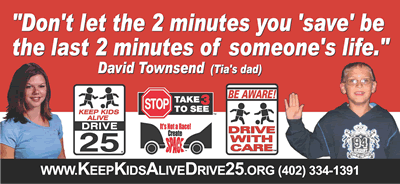"Don't let the 2 minutes you save
be the last 2 minutes of someone's life."
David Townsend, Tia's Dad
(11 year-old Tia died when struck in a marked crosswalk with a Stop sign
by a motorist who veered around the car stopped in front of him)
I hope not.
Today the time is now. Tomorrow the time will be now. Next week, next month, next year, the time will still be now. The time is always right to practice safe driving behaviors.
Do you need directions about what to do now?
Here are several...
...walk around your vehicle to make sure their are no kids playing behind or around it before I get in.
...hide your cell phone - where you can't reach it - so that it does not serve as a distraction as you drive (remember when no one had to worry about doing this? Cell phone use while driving is becoming the new "Drunk Driving")
...don't drink and drive
...buckle up every trip and expecting all passengers to do so, no matter the distance
of the trip
...stop at stop signs and taking 3 seconds to look left, look right, look left again - work hard to make sure the street really is clear of other moving vehicles, pedestrians trying to cross, and cyclists making their way along roadways.
...observe the speed limit, and drive slower when weather conditions or the presence of children at play, pedestrians, and cyclists dictate doing so.
...be a thinker and use your blinker to signal all turns and lane changes
...create 3-4 seconds of following distance between your vehicle and the one in front of you so you have time to react to the driving actions of others.
Repetitive practice of all these behaviors, and more, is what helps us improve our driving skills each day. None of us will ever be perfect drivers - but, are we - you - driven toward perfection each time we (you) get behind the wheel? Our answer and subsequent actions can be a matter of life and death, possibly even our (your) own.
...hide your cell phone - where you can't reach it - so that it does not serve as a distraction as you drive (remember when no one had to worry about doing this? Cell phone use while driving is becoming the new "Drunk Driving")
...don't drink and drive
...buckle up every trip and expecting all passengers to do so, no matter the distance
...stop at stop signs and taking 3 seconds to look left, look right, look left again - work hard to make sure the street really is clear of other moving vehicles, pedestrians trying to cross, and cyclists making their way along roadways.
...observe the speed limit, and drive slower when weather conditions or the presence of children at play, pedestrians, and cyclists dictate doing so.
...be a thinker and use your blinker to signal all turns and lane changes
...create 3-4 seconds of following distance between your vehicle and the one in front of you so you have time to react to the driving actions of others.
Repetitive practice of all these behaviors, and more, is what helps us improve our driving skills each day. None of us will ever be perfect drivers - but, are we - you - driven toward perfection each time we (you) get behind the wheel? Our answer and subsequent actions can be a matter of life and death, possibly even our (your) own.
It's About Kids! It's About Safety! It's About Caring! It's About Time!®
Safe travels,
Keep Kids Alive Drive 25®
A Non-Profit "For Action"
Organization 501(c)(3)
402-334-1391
12418 C Street
Omaha, NE
68144
Make your donation to support the KKAD25 mission today @ KKAD25 Donate. A personal thank you note
will arrive in your mailbox (not your e-mail box).
























